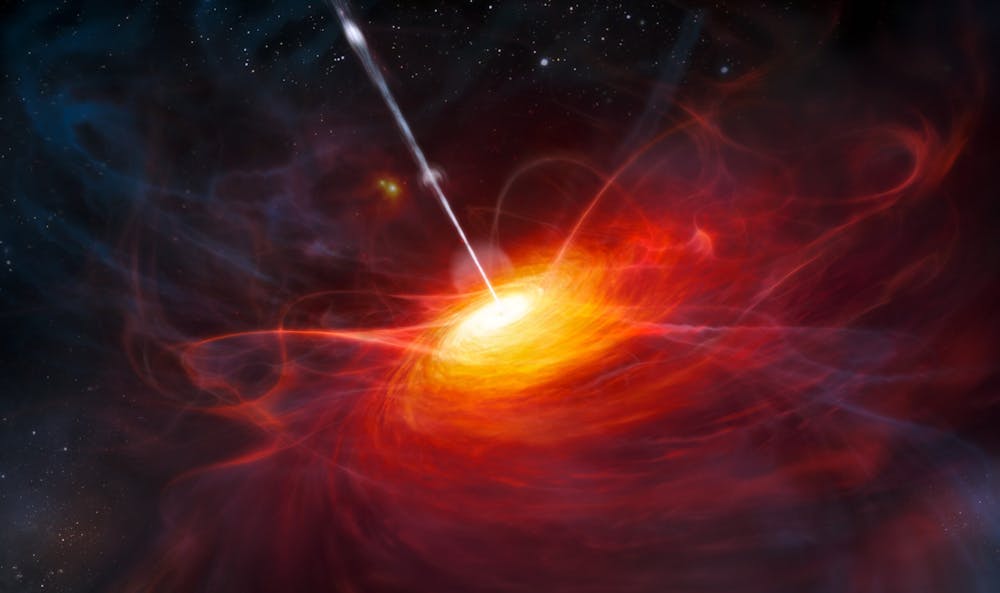Supermassive black holes have long fascinated physicists and astronomers. Almost every large galaxy has a supermassive black hole located at its center, and with solar masses ranging from 100,000 to billions or even hundreds of billions, these structures bind galaxies. As gas falls onto its accretion disks, it heats up and releases powerful waves of electromagnetic energy. How do these cosmic maelstroms emerge? What could enable their formation?
An international group of cosmologists led by Homewood Professor of Physics and Astronomy Joseph Silk proposed a novel solution to this question in a paper recently published in the Astrophysical Journal Letters. Silk’s team proposes that not only did supermassive black holes dominate the composition of the early universe, but they also seeded stars and developed galaxies.
Recent data from the James Webb Space Telescope (JWST), capable of looking farther into the early universe than any of its predecessors due to infrared sensors, left scientists confused: The early universe was filled with both far more supermassive black holes and luminous galaxies than expected. Silk’s team analyzed this data and concluded that these two factors are directly related: The existence of supermassive black holes leads directly to luminous galaxies.
Silk discussed these findings in an interview with The News-Letter.
“What we have discovered — it’s a new idea — is that the presence of black holes is often correlated with those same galaxies which contain very luminous and very large star formations. We think it's extremely unlikely these things are independent of each other,” he said. “As you go back in time, the galaxies that surrounded black holes have relatively fewer stars than today. This suggested to us two things: One is that the black holes most likely came first. Second, if that were the case, then the energy they produce when they collect gas from their surroundings, stimulated large amounts of star formation.”
Black holes form when massive stars implode on themselves. The team hypothesized that the first black holes were concentrated in the center of early galaxies, where dense gas clouds enabled rapid star formation. As these first stars died and created black holes, they were drawn gravitationally towards one another, coalescing in the galactic center and merging. This process continues leading to increasingly massive black holes. Gas from the galactic nucleus also falls onto the developing black hole, giving it even more mass.
As these supermassive black holes form, they begin pulling the gas around them into an accretion disk, a region of hot gas circling the black hole and releasing jets of ionized particles. These jets spur the creation of new stars.
“When the black holes form, they're uprooting lots of gas from their surroundings, and they act like these incredible factories of energy. Gas falls on the black hole and gets converted into a high energy outflow of very, very hot gas,” Silk explained. “This happens because the black hole acts like a gigantic furnace with directionality attached to it because it's spinning very fast. That tends to jerk stuff out. The outflows overwhelm the gas clouds nearby, crush them and turn them into stars.”
This process continues until the black holes reach a critical mass at which point their energetic outflows are so overwhelming that, rather than crush surrounding gas clouds into stars, they clear them out, dispelling their contents. At this point, the black hole prompts star formation to cease.
Silk emphasized that this theory, like many in astronomy, is driven by observation. New theories emerge hand in hand with new telescopic technology — such as JWST — that enable more accurate observations.
“We've had a very difficult time extrapolating from what we observe with the Hubble [Space] Telescope to these further away, earlier-in-time regions of the universe. We had various theories interpreting what [the Hubble Space Telescope] found, and they failed to predict this new phenomenon,” Silk said. “In astronomy, we play catch up: We find these amazing things with our new telescopes and then interpret them, model them and do our best, only to find out that — when you take another step back in time — it’s very hard to predict what you’ll see.”
Over his career, Silk has authored over 700 papers and earned countless laurels in the astronomy community. He recently released Back to the Moon: The Next Giant Leap for Humankind, which offers an impassioned argument in favor of lunar science. His current project investigating the development of early black holes has been ongoing for over a decade, but now the tools available are capable of surveying the past unlike ever before. Silk’s recent paper concluded with a set of observations to be taken in the coming years to further validate this theory.
“This particular project dealing with how you make black holes and how they interact is something I've been working on for at least 10 years now. It’s only with the [JWST], that we finally have the data to really test these theories and refine these theories,” Silk said.





